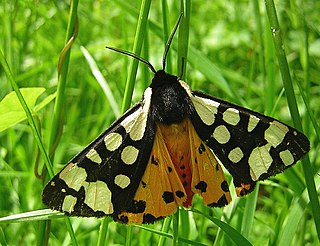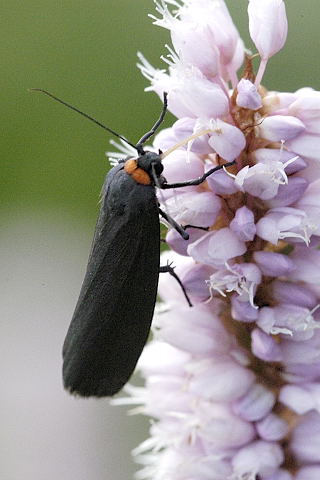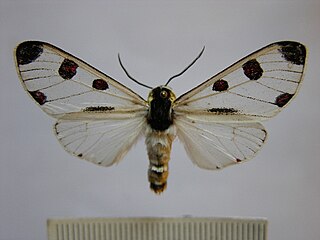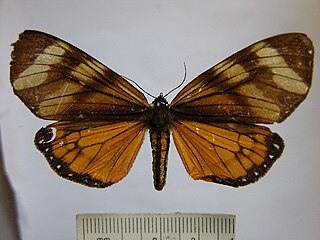
Noctuoidea is the superfamily of noctuid or "owlet" moths, and has more than 70,000 described species, the largest number of any Lepidopteran superfamily. Its classification has not yet reached a satisfactory or stable state. Since the end of the 20th century, increasing availability of molecular phylogenetic data for this hugely successful radiation has led to several competing proposals for a taxonomic arrangement that correctly represents the relationships between the major lineages.

The Arctiini are a tribe of tiger moths in the family Erebidae.

The Phaegopterina are a subtribe of tiger moths in the tribe Arctiini, which is part of the family Erebidae. The subtribe was described by William Forsell Kirby in 1892. 469 species of Phaegopterina are present and 52 that are recently discovered in Brazil.

The Arctiina are a subtribe of moths in the family Erebidae.

The Lithosiini are a tribe of lichen moths in the family Erebidae. The taxon was described by Gustaf Johan Billberg in 1820.
Myserla is a monotypic moth genus in the subfamily Arctiinae. Its only species, Myserla transversa, is found in Brazil. The species was first described as Sermyla transversa by Francis Walker in 1854. The name Sermyla was replaced by Myserla in 2017, as the former name was a junior homonym of a gastropod genus described earlier in 1854.

Calodesma maculifrons is a moth of the family Erebidae. It was described by Francis Walker in 1865. It is found in Mexico, Honduras, Costa Rica, Guatemala, Panama and Ecuador.

Dysschema arema is a moth of the family Erebidae first described by Jean Baptiste Boisduval in 1870. It is found in Nicaragua, Venezuela, Peru, Brazil and Ecuador.

Dysschema boisduvalii is a moth of the family Erebidae first described by Jan van der Hoeven in 1840. It is found in Paraguay, Colombia, Brazil and Argentina.

Dysschema eurocilia is a moth of the family Erebidae first described by Pieter Cramer in 1777. It is a common species throughout tropical America, where it has been recorded from the Antilles, Central America and South America.
Dysschema hilarum is a moth of the family Erebidae first described by Weymer in 1895. It is found in Brazil.

Dysschema leda is a moth of the family Erebidae first described by Herbert Druce in 1884. It is found in Costa Rica.
Dysschema pictum is a moth of the family Erebidae first described by Félix Édouard Guérin-Méneville in 1844. It is found in Brazil.

Dysschema thyridinum is a moth of the family Erebidae first described by Arthur Gardiner Butler in 1871. It is found in Ecuador and Peru.
Pseudophaloe ninonia is a moth of the family Erebidae first described by Herbert Druce in 1884. It is found in Panama and Costa Rica.
Pseudophaloe schausii is a moth of the family Erebidae first described by Henry Edwards in 1884. It is found in Mexico and Guatemala.

The Euchromiina are a subtribe of tiger moths in the family Erebidae. It was described by Arthur Gardiner Butler in 1876. Many species in the subtribe are mimics of wasps. Euchromiina have always been considered closely related to the subtribe Ctenuchina due to their similarity to moths and wasps. These two subtribes make up around 3,000 valid species, the majority of which occur in the Neotropics.

The Cisthenina are a subtribe of lichen moths in the family Erebidae, currently containing 428 described species.

The Lithosiina are a subtribe of lichen moths in the family Erebidae. The taxon was erected by Gustaf Johan Billberg in 1820.

Nudariina is a subtribe of lichen moths in the family Erebidae. The taxon was described by Carl Julius Bernhard Börner in 1920.















